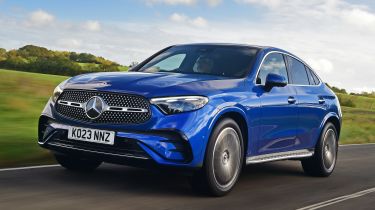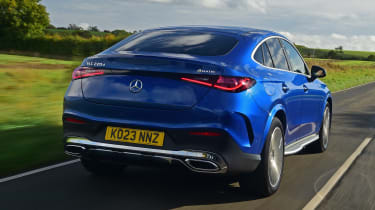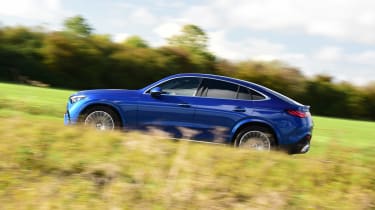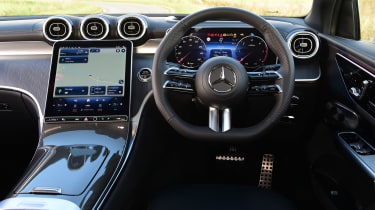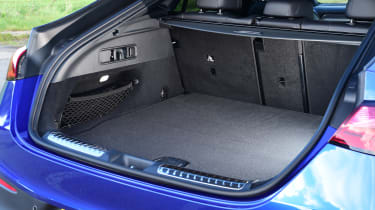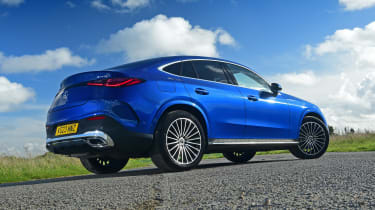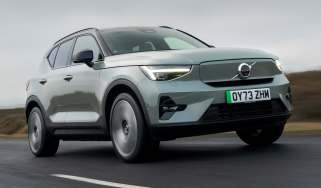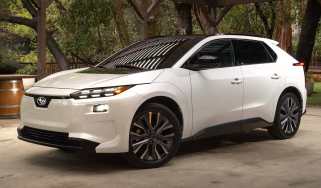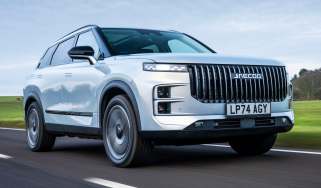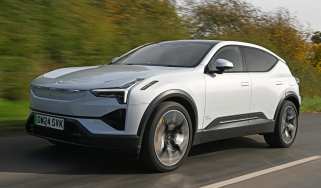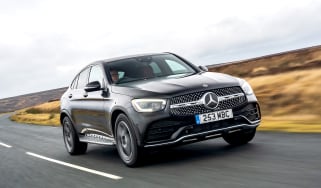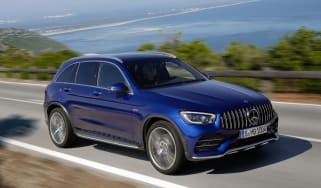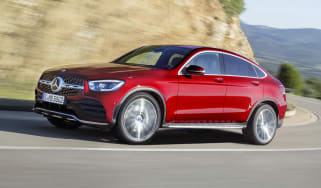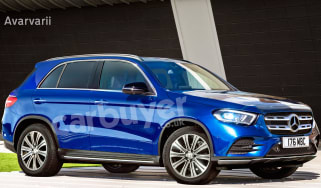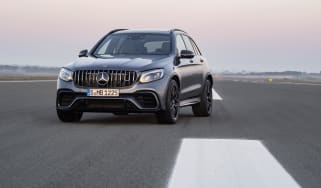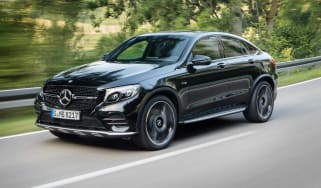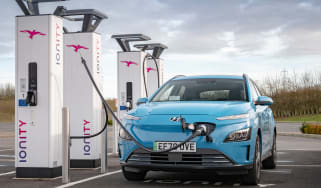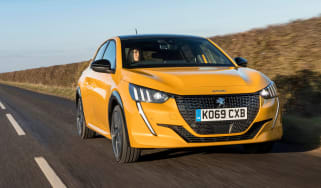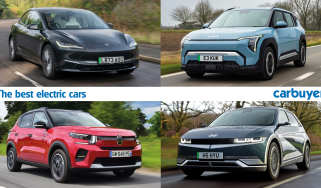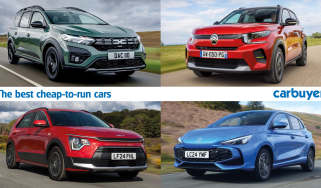Mercedes GLC Coupe review - sleek, but practicality suffers
“The Mercedes GLC Coupe is less practical than the standard SUV, but it may appeal if its fashionable design is your priority”
Pros
- Sleek coupe styling
- Comfortable
- Impressive PHEV
Cons
- More expensive and smaller
- Unexciting to drive
- Pricey top trim levels
Verdict – is the Mercedes GLC Coupe a good car?
The Mercedes GLC Coupe is an even more stylish version of the standard Mercedes GLC, offering the same premium interior and comfy ride with a much sleeker exterior package. For most families, we wouldn’t recommend the Coupe, given it’s less practical and more expensive than the standard car. However, if styling is more important, it’s within your budget, and you’re taken by the Coupe’s individuality, it’s easy to see its appeal.
Mercedes GLC Coupe models, specs and alternatives
The Mercedes GLC Coupe is the sleekly-styled version of the standard Mercedes GLC SUV which taps into the growing market for coupe-SUVs that once seemed like a niche prospect. It aims to offer the high, comfortable driving position of an SUV with flowing, sports car-inspired looks. It’s not cheap, however, costing from just below £49,000, and commanding a premium of around £5,000 over the standard GLC.
Recent years have seen rapid growth in the number of coupe SUVs on the market, with models such as the BMW X4 and Audi Q5 Sportback, as well as the Porsche Macan that’s soon to get even more swoopy looks and electric power. While these premium brands are more well-established in the coupe-SUV market, mainstream brands have also launched models like the Renault Rafale and Skoda Enyaq Coupe, for a similar look on a budget.
More reviews
Rather than fully redesign the GLC’s exterior, the Mercedes GLC Coupe looks much like the more upright model at the front, but it’s distinguished by a sloping roofline and aggressive stance towards the back. The Coupe is also 47mm longer than the standard SUV.
The GLC Coupe is available with a choice between three powertrain options equipped with mild-hybrid technology: two of these are based on the same excellent 2.0-litre diesel engine albeit in a choice of power outputs, plus a sole petrol engine and a plug-in hybrid.
The aforementioned engines are taken from the standard SUV range, and while the plug-in hybrid petrol 300 e was absent for the Coupe – it’s now on sale in the UK. Bear this in mind if you’re choosing between the GLC SUV and Coupe as a company car, as the plug-in hybrid system has the lowest emissions, putting it into a low Benefit-in-Kind (BiK) category that’s only bettered by electric SUVs.
Despite the GLC Coupe’s sporting looks, make no mistake that it’s designed with comfort in mind first and foremost, and despite high power figures and decent performance specs on paper, it’s not as exciting to drive as the Porsche Macan. That said, it’s a very refined car, with minimal road and wind noise, which will hold appeal if that’s what you’re after, and we found the mild-hybrid diesel to be one of the best on offer.
In the UK, the Coupe range kicks off with AMG Line, moving up through AMG Line Premium, with the AMG Line Premium Plus that we’ve tested, sitting at the top of the range. There’s also an Urban Edition, but this is only currently offered as a plug-in hybrid model. Prices can vary quite significantly depending on the trim, with the top-spec model more expensive than the AMG Line car by about £8,000 with the same engine.
| Trim levels | Power options |
|
|
Mercedes GLC Coupe alternatives
It might seem like a small niche, but there are a few different flavours of coupe-SUV available. The BMW X4 and Porsche Macan offer the most sporting drive, while the GLC Coupe and Audi Q5 Sportback are good all-rounders with lots of tech. The Evoque is stylish and the best performer off-road thanks to Land Rover’s all-terrain know-how.
MPG, running costs & CO2 emissions
When it comes to fuel economy, the most frugal of the regular GLC Coupe models is the entry-level 220 d diesel version, which gets an official figure of up to 53.3mpg with CO2 emissions from 141g/km, putting it in the lowest BiK bracket of the Coupe lineup. We found we could even beat its official figure on longer runs, returning closer to 60mpg.
The 300 d diesel model is not much worse despite its higher power figure, returning up to 49.6mpg and CO2 emissions from 150g/km depending on the trim.
Now the plug-in hybrid GLC 300 e powertrain has arrived in the Coupe, however, this becomes the economy champion, and the top pick for company car choosers. Thanks to a large 31.2kWh battery, it can manage up to 83 miles on electric power alone – far more than most PHEV rivals. This gives it official economy figures of 565mpg and 12g/km, putting it in a low Benefit-in-Kind band of 5%, but as with all PHEVs, it will be hard to match these figures without frequently charging and on longer trips.
The GLC Coupe 300 is the least fuel efficient, but that’s to be expected when pitting petrol against diesel. Official figures put the 300’s fuel economy figure at up to 37.7mpg and its CO2 emissions from 172g/km, so it’s more efficient than the equivalent Audi Q5, Porsche Macan and Alfa Romeo Stelvio.
| Model | Fuel economy | CO2 emissions |
| Mercedes GLC Coupe 220 d | 52.3mpg | 140-141g/km |
| Mercedes GLC Coupe 300 d | 48.7-49.6mpg | 149-150g/km |
| Mercedes GLC Coupe 300 | 37.2-37.7mpg | 170-172g/km |
| Mercedes GLC Coupe 300 e | 565mpg | 12g/km |
Insurance
The entry-level 220 d in AMG Line trim will be the cheapest to insure of the lineup, sitting in group 41, going up to 42 in AMG Line Premium Plus guise. The 300 petrol starts from group 43 in entry-level trim, increasing to group 44 in top-spec guise. The most expensive to insure are the 300 d diesel model, which starts from group 44 in AMG Line Premium trim and sits in group 45 for AMG Premium Plus, along with the GLC 300 e that’s in groups 47 to 49 out of 50.
Engines, drive & performance
Despite what its sporting coupe looks might suggest, there’s no question the Mercedes GLC Coupe is built with comfort in mind, rather than driver engagement. As a result, keen drivers might take issue with its lack of excitement on the road, but just like the standard GLC SUV, the Coupe is incredibly refined and comfortable.
Just like in the GLC SUV, the driving position is high, but visibility is negatively impacted to the rear, given the sloping roofline’s smaller rear window – even forward visibility isn’t great, but is helped by the ‘transparent bonnet’ feature on top-spec cars, which is intended for off-road use but is equally useful when manoeuvring into tight parking spaces.
We drove the Mercedes GLC Coupe 300 with the 2.0-litre mild-hybrid turbocharged petrol engine first, and the car was equipped with Mercedes’ AIRMATIC adaptive suspension and four-wheel steering – both features that won’t be available on the car in the UK for the foreseeable future. That’s a pity because our test car rode very well, and the rear-wheel steering was useful for tighter manoeuvres around town.
This was reinforced when we tested a mild-hybrid diesel in the UK, which rode firmly on all but the least taxing surfaces. Despite this, it felt relatively ponderous when faced with lots of corners, even if its steering is a highlight thanks to its deft accuracy.
All versions of the Mercedes GLC Coupe come with the brand’s 4MATIC all-wheel drive system and a nine-speed automatic transmission. It shifts smoothly, but there can be a slight delay when you put your foot down, even when using the manual paddles behind the steering wheel.
Initially, the powertrain lineup was somewhat let down by the lack of a plug-in hybrid model for the Coupe range, but now it has arrived, buyers after a coupe-SUV that can glide around town in silence in pure electric mode are catered for. We found the mild-hybrid diesel to be a superb pick, however, and it’s a shame it’s likely to go largely unnoticed as diesel continues to fall out of favour.
Both the GLC SUV and Coupe models come equipped with four drive mode settings comprising Eco, Comfort, Sport and Individual. Sport mode makes the car hold onto the gears for longer allowing for more sprightly performance and firmer steering. Eco prioritises a more frugal drive, while Comfort optimises the suspension to help iron out lumps and bumps in the road. Meanwhile, Individual allows the driver to configure their own settings based on their personal preferences.
Diesel models
Although many manufacturers have abandoned diesel as an engine option due to falling demand, Mercedes still offers the GLC Coupe with a 2.0-litre mild-hybrid turbocharged diesel in two power outputs. The entry-level 220 d comes with 194bhp, propelling the car from zero to 62mph in 8.1 seconds and onto a top speed of 140mph. This engine was the highlight of the GLC Coupe we tested on UK roads, with a flexible and smooth power delivery, and mild-hybrid assistance that helps it feel punchy when pulling away. It’s also very well suited to the nine-speed automatic.
For a little more oomph, there’s the 300 d, which uses the same engine tuned up to 266bhp making it the most powerful GLC Coupe model available. Despite this, its zero to 62mph time is 6.4 seconds – 0.2 seconds slower than the 300 petrol model – and it has a top speed of 155mph.
| Model | Power | 0-62mph | Top speed |
|
220d 4MATIC 300d 4MATIC |
194bhp 266bhp |
8.1 seconds 6.4 seconds |
140mph 155mph |
Petrol models
The sole petrol model of the GLC Coupe is the 300, which makes use of a 2.0-litre mild-hybrid turbocharged engine with 255bhp. It sits between the two diesel engines in terms of pure power, but has the fasted sprint time of the lineup, managing zero to 62mph in just 6.2 seconds. Its top speed is just below that of the 300 d, at 153mph.
When we drove the GLC Coupe our test car was equipped with this engine, which – despite being only marginally slower on paper compared with the equivalent Audi Q5 Sportback and Porsche Macan T – felt fairly sedate, likely because of the car’s comfort-focussed tuning and smooth, yet somewhat sluggish nine-speed gearbox. Turbo lag is virtually non-existent thanks to the mild-hybrid system’s assistance at lower speeds, however.
| Model | Power | 0-62mph | Top speed |
| 300 4MATIC | 255bhp | 6.2 seconds | 153mph |
Plug-in hybrid models
The Mercedes GLC Coupe now gets the petrol-based plug-in hybrid powertrain offered in the GLC SUV. This combines a 2.0-litre turbocharged petrol engine with an electric motor, giving the GLC 300 e enough punch to accelerate from 0-62mph in 6.7 seconds. That should be quick enough for most drivers, but it’s slightly behind the 300 d and petrol 300 owing partly to the extra weight of its battery. We’ll also need to drive this version in the UK to see how it affects the handling.
| Model | Power | 0-62mph | Top speed |
| 300 e 4MATIC | 308bhp | 6.7 seconds | 135mph |
Interior & comfort
Mercedes is known for its beautifully-designed and high-quality interiors, and while that’s largely the case for this latest GLC Coupe model, some of the finishes have a bit of a plastic feel and can creak over rough surfaces. The GLC Coupe’s cabin is the same as the GLC SUV’s, which features a 12.3-inch central touchscreen and an 11.9-inch digital gauge cluster in front of the driver.
Infotainment and navigation
The GLC and GLC Coupe get the most recent version of Mercedes’ MBUX infotainment system. When we tested it, we found it worked well on the whole, with great screen resolution and a premium feel, although on a hot day, we found the screen got very warm, causing the system to suffer from a delayed response to our inputs.
In more typical British weather, the system is snappy and the logical placement of controls for functions like the climate control makes it easy to use on a daily basis. The steering wheel is something of another matter, with no fewer than four spokes with touch-sensitive controls, that we found difficult to become accustomed to.
Equipment
The GLC Coupe’s premium image and price means it comes fairly well equipped as standard, especially given the lower spec Avantgarde trim level sold elsewhere in Europe is skipped for the UK. UK cars start from the sportier-looking AMG Line trim, with the entry-level car getting 19-inch alloy wheels, LED headlights with Adaptive Highbeam Assist, privacy glass, heated sports seats, dual-zone climate control and wireless smartphone charging.
The mid-range AMG Line Premium model swaps out the 19-inch wheels for different 20-inch five-spoke ones to give a slightly different look. It gets a memory function for the electronically adjustable front seats and steering column, plus heat and noise insulated glass, keyless entry and go, a dashcam, traffic sign recognition tech, MBUX augmented reality navigation and a ‘transparent bonnet’ which allows for improved visibility of the terrain through the infotainment screen when off-roading.
AMG Line Premium also adds the Mercedes Digital Light system, which is an innovative system enabling the headlights to react to changes in the road up ahead, adjusting the height of the beams depending on the terrain, and it can specifically block out dazzling light for individual cars up ahead while keeping on the high beams. On AMG Line Premium Plus, this gets an added projection function, which shines information from surrounding road signs onto the tarmac ahead of you.
AMG Line Premium Plus also gets real leather upholstery, compared to the other trims’ Artico man-made leather, a different set of 20-inch alloy wheels, a panoramic electric sunroof, four-zone climate control, a premium Burmester sound system, a head-up display, and 360-degree camera.
Buyers can also pick the Urban Edition, but this is currently only offered with the 300 e plug-in hybrid powertrain. Sitting below AMG Line, and costing around £4,000 less, it comes with 20-inch black alloy wheels, the ‘Night package’ with black exterior trim, upgraded adaptive LED headlights, a powered tailgate, chrome exhaust finishers and a unique grille design.
Key features | ||
|
Trim name AMG Line
|
AMG Line Premium (AMG Line plus…)
|
AMG Line Premium Plus (AMG Line Premium plus…)
|
Practicality & boot space
As a result of the Mercedes GLC Coupe’s sloping roofline, there’s less interior and boot space than in the standard GLC, and rear headroom is reduced by the coupe shape. While rear passenger space is still fairly good, the Coupe’s design does mean it lets in less natural light than the standard model, and this is even apparent in the front seats.
| Size comparison | |||
| Model | Length | Width | Height |
| Mercedes GLC Coupe | 4,764mm | 2,075mm | 1,605mm |
| Audi Q5 Sportback | 4,689mm | 2,140mm | 1,660mm |
| Porsche Macan | 4,726mm | 2,097mm | 1,621mm |
| BMW X4 | 4,752mm | 1,938mm | 1,621mm |
Boot space
The GLC SUV’s 620-litre boot drops to 545 litres in the Coupe version, so it’s still a good size, despite the car’s sloping roofline. It’s likely helped somewhat by the Coupe’s slightly increased length, so the result is a sportier design which doesn’t affect practicality as negatively as it could have. It’s also one of the most generous boot capacities offered amongst rival coupe-SUVs, sitting just ahead of the BMW X4’s 525 litres and much larger than that of the Porsche Macan’s 488-litre boot.
With the seats folded down, the 545-litre boot increases to 1,490 litres, so there should be plenty of space should you need to transport larger items. All Mercedes GLC Coupe models come with a powered tailgate, allowing the boot to be opened and closed automatically at the touch of a button.
| Boot space comparison | |
| Model | Boot space |
| Mercedes GLC Coupe | 545 litres |
| Audi Q5 Sportback | 510 litres |
| Porsche Macan | 488 litres |
| BMW X4 | 525 litres |
Reliability & safety
As the latest Mercedes GLC Coupe is so new, it’s yet to appear in our Driver Power customer satisfaction survey, but the brand as a whole has performed poorly in recent years. Mercedes was behind many of its luxury rival brands in 25th place out of 32 manufacturers in 2023.
All Mercedes models come with a three-year unlimited-mile warranty on par with that of BMW and Porsche, and slightly better than Audi’s three-year 60,000-mile warranty.
Reliability
Although there isn’t enough reliability information for the GLC SUV or Coupe yet specifically, 28% of Mercedes owners as a whole reported a fault with their car in the first year of ownership, which is slightly worse than average. A large percentage of these faults were related to their cars’ electrics, and a higher percentage of issues were engine-related compared with those of many rivals.
Safety
While the GLC Coupe model hasn’t been crash-tested specifically, the GLC SUV on which it’s based was tested by Euro NCAP and achieved an impressive five stars. The GLC Coupe also comes with a comprehensive suite of safety technology, so it looks like it will be a very safe car to drive.
Visit our sister site Auto Express for an alternative view on the Mercedes GLC Coupe...
Which Is Best?
Cheapest
- NameGLC 220d 4Matic AMG Line 5dr 9G-Tronic
- Gearbox typeSemi-auto
- RRP£60,485
Most Economical
- NameGLC 300e 4Matic Urban Edition 5dr 9G-Tronic
- Gearbox typeSemi-auto
- RRP£66,450
Fastest
- NameGLC 300 4Matic AMG Line 5dr 9G-Tronic
- Gearbox typeSemi-auto
- RRP£62,120
